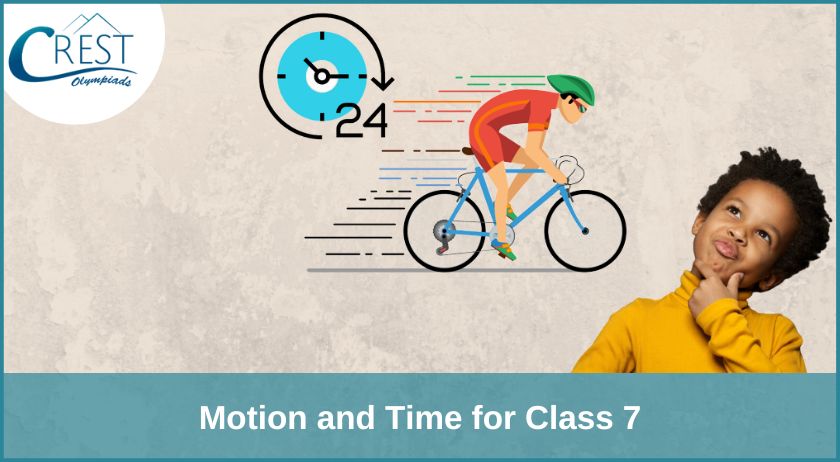Motion and time for class 7 is chapter 13 in the NCERT Science book. Our notes are created under the subject experts' guidance which is totally error-free and precise to the topic. Students can take help from our notes to prepare for CREST Science Olympiad (CSO) for class 7 and other similar competitions. Notes provided here for class 7 Science chapter 13 will enable students to understand the topic with a clear understanding. These notes include explained definitions with examples to make it easier for the students to understand and later comprehend the topic.
Class 7 Science Chapter 13 pdf is also available to download for free to make learning flexible for students.
Notes for Motion and Time for Class 7
Motion
When an object changes its position with respect to time. The object is said to be in motion.
Slow and Fast Motion
If object ‘A’ covers a distance in less time and object ‘B’ covers the same distance in more time. Object A is called a faster-moving object, and object B is called a slower-moving object. In other words, object A has a faster motion and object B has a slower motion.
Types of Motion
Rectilinear Motion
The motion of an object along a straight line is known as rectilinear motion.
For example, Motion of a motorcycle on a straight bridge.
Curvilinear Motion
The motion of an object along a curved line is known as curvilinear motion.
For example, Motion of a car or any other moving object along a curved line.
Circular Motion
The motion of an object along a circle is known as circular motion.
For example, A cyclist motions around a circular park, a child on a merry-go-round.
Periodic Motion
If the motion of an object, repeats itself after regular intervals of time, the motion is said to be periodic motion.
For example, Motion of a swing
Rotational Motion
The motion possessed by an object when it spins about a fixed axis, is called rotational motion.
For example, Motion of a spinning top
Speed
Distance covered by an object in unit time is called speed.
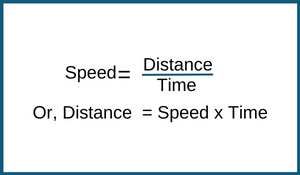
Types of Speed
There are three types of speed: Uniform speed, Non-Uniform speed, and Average speed.
Uniform Speed
If an object covers an equal distance in an equal interval of time, the motion of the object is said to be uniform and the speed with which the object is traveling will be uniform speed.
Non-uniform Speed
If an object does not cover an equal distance in an equal interval of time, the motion of the object is said to be non-uniform motion and the speed with which the object is traveling will be non-uniform speed.
Average Speed
Total distance covered divided by total time taken is known as average speed.
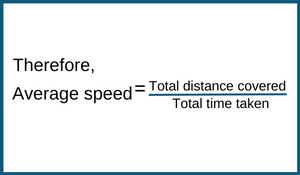
Speed is also known as VELOCITY.
Oscillatory Motion
The to-and-fro motion of an object about its mean position is known as oscillatory motion.
For example, Motion of a pendulum.
A device having a string suspended with a fixed point with a bob at bottom is called a pendulum.
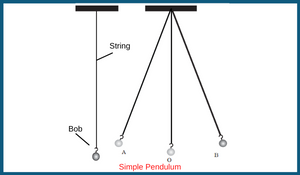
The motion of a pendulum starting from one extreme end to another extreme end and back to the first extreme end is called one oscillation. Similarly, one oscillation is the motion of a simple pendulum from its mean position to the extreme left and extreme right and back to the mean position.
Time Period
Time taken to complete one oscillation by the pendulum is called time period.
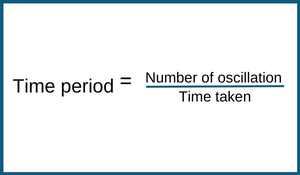
Unit of Time
Time is measured in seconds. Thus, a unit of time is a second. Second is denoted by ‘s’.
60 second = 1 minute
60 minute = 1 hour
24 hour = 1 day
7 day = 1 week
365 days = 1 year
Unit of speed
Unit of speed is meter/second (m/s), metre/minute (m/min) or kilometer/hour (km/h).
1000 metre (m) = 1 kilometer (km)
Speedometer
A device used to measure the speed of a vehicle is called a speedometer.
Odometer
A device used to measure the distance covered by a vehicle is called an odometer.
Distance Time Graph
When distance covered by an object and the time taken to cover the distance is represented on a graph, the graph is called a distance-time graph.
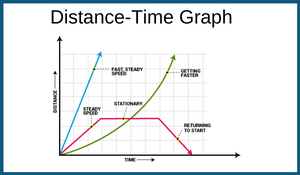
Source: Byjus
Slope of the distance-time graph gives of the speed of the object.
The steeper the slope of the graph, the more is the speed of the object.
Practice Questions on Motion and Time for Class 7
Q1. The distance between two stations is 240 km. A train takes 4 hours to cover this distance. Calculate the speed of the train.
Solution: Distance = 240 km
Time taken = 4 hours
Speed = Distance covered/time taken = 240 km/4 h
= 60 km/h
Speed of train = 60 km/h
Q2. Salma takes 15 minutes from her house to reach her school on a bicycle. If the bicycle has a speed of 2 m/min, calculate the distance between her house and the school.
Solution: Time taken =15 min
Speed = 2 m/min
Distance = speed x time = 2 x 15 = 30 m
Distance between Salma’s school and her house is 30 m.
Q3. Which of the following distance time graphs a truck moving with a speed which is not constant?
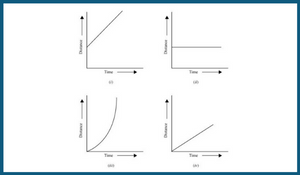
Solution: (iii)
A curved line on the distance-time graph indicates that the truck is moving at a speed that is not constant.
Q4. The odometer of a car reads 57321.0 km when the clock shows the time 08:30 AM. What is the distance moved by car, if at 08:50 AM, the odometer reading has changed to 57336.0 km? Calculate the speed of the car in km/min during this time. Express the speed in km/h also.
Solution: Distance = 57336.0 km – 57321 km =15 km
Speed in km/min =15km/20 min = 3/4 km/min
Speed in km/hr =15 km/1/3 hr
= (15 x 3) km/hr
=45 km/hr
Q5. A car moves with a speed of 40 km/h for 15 minutes and then with a speed of 60 km/h for the next 15 minutes. The total distance covered by the car is:
(i) 100 km (ii) 25 km (iii) 15 km (iv) 10 km
Answer: (ii) 25 km
CREST Science Workbooks
As extra information, more familiar materials are also easily accessible for students to prepare for various subject matter like motion and time for class 7. If one wants to ace their performance, all are welcome to upgrade their learning by considering CREST Olympiads workbooks. These workbooks have engaging content to make learning easy and enjoyable for class 7 students. It will also benefit them to practice and prepare for CREST Science Olympiad (CSO) and similar exams. Moreover, these notes are also helpful to crack standard school exams.
CREST Science workbook for class 7 can be considered by the students because of the following features -
- Includes a detailed explanation of each topic with practice questionnaires.
- Covers class 7 previous year paper of the CREST Science Olympiad.
- Provides answer key for all questions
Proceed now to purchase Olympiad books.
Useful Links:
CREST Science Olympiad Book (First Chapter) PDF for Class 7 (Free Download)
CREST Olympiads Books for Class 7
Notes PDF for Motion and Time for Class 7
To download the free notes PDF for Motion and Time for class 7, click the link below.
Download Notes PDF for Motion and Time for Class 7
Conclusion
With confidence, provided notes have served as a benefit for third-grade children to comprehend motion and time for class 7. We made an effort to provide clear and precise master notes. We want to remind students to download the PDF because doing so will help them review the idea at a later time. We would greatly love to continue giving knowledge about several more Science-related topics in the bright days to come.

